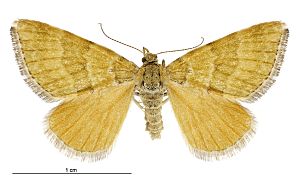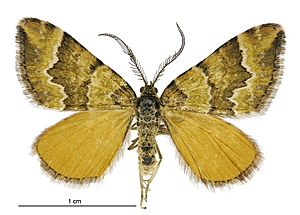Asaphodes cinnabari facts for kids
Quick facts for kids Asaphodes cinnabari |
|
|---|---|
 |
|
| Female | |
 |
|
| Male | |
| Scientific classification | |
| Synonyms | |
|
Asaphodes cinnabari is a special kind of moth that belongs to the Geometridae family. This moth is found only in New Zealand, which means it's endemic there. You can spot it in the Otago and Southland regions, especially in wet, swampy areas high up in the mountains.
Contents
Discovering the Cinnabar Moth
This moth was first described in 1912 by a scientist named George Howes. He called it Larentia cinnabari. He found the first specimen in the Nevis Valley in Central Otago. His brother, A. A. Howes, actually discovered the species in the Garvie Mountains.
Later, in 1928, another scientist named George Hudson wrote about this moth in his book, The Butterflies and Moths of New Zealand. He used the name Xanthorhoe cinnabaris. Over the years, the moth's scientific name changed a few times. In 1971, it was placed in the Asaphodes group. The main specimen used to describe the species, called a holotype, is kept at the Natural History Museum, London.
What Does It Look Like?
The Asaphodes cinnabari moth is quite small.
- Males usually have a wingspan of about 20 millimeters (less than an inch).
- Females are a bit larger, with a wingspan of about 22 millimeters.
Their front wings are a pale orange color. They have brown and light yellow-brown markings.
- Near the base of the wing, there's a brown area with a dark edge.
- Then comes a thin, pale yellow-brown line, followed by more pale orange.
- A larger dark-brown area is in the middle of the wing, also outlined with pale yellow-brown lines. This brown area bends outwards in the middle.
- Near the wing tips, there's some dark shading and a slanted dark patch.
- The rest of the wing, towards the outer edge, is pale orange.
- There's a row of small dark dots along the very edge of the wing.
- The fringes of the wings (called cilia) are purplish-brown.
The hind wings are a uniform orange color with small dark dots along their edges. The females look similar to the males but are usually paler in color. The exact shades and how much dark marking they have can vary a lot between individual moths.
Where Does It Live?
This moth is only found in New Zealand. You can find it in the Otago and Southland areas. Besides the place where it was first found, it has also been seen in places like the Greenstone Valley and Gorge Hill in Mossburn.
Life Cycle and Habits
Adult Asaphodes cinnabari moths are usually seen flying around in November.
Food and Home
This moth is an alpine species, meaning it lives in high, mountainous areas. It has been found living among tussock grasses in swampy places. Scientists have also raised A. cinnabari in special conditions, and they found that the caterpillars can eat a plant called Hypochaeris radicata.
What Threatens This Moth?
Sadly, the places where this moth lives are shrinking. The swampy habitats it relies on are being drained and destroyed. This loss of habitat has caused the number of these moths to decrease, especially in Southland.
Images for kids


